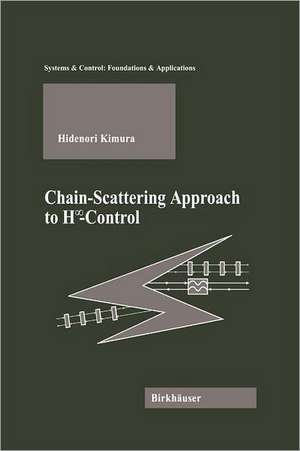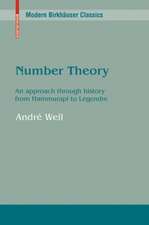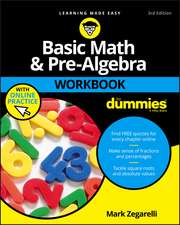Chain-Scattering Approach to H∞Control: Systems & Control: Foundations & Applications
Autor Hidenori Kimuraen Limba Engleză Paperback – 14 oct 2011
Din seria Systems & Control: Foundations & Applications
- 18%
 Preț: 1050.35 lei
Preț: 1050.35 lei - 17%
 Preț: 490.57 lei
Preț: 490.57 lei - 15%
 Preț: 654.95 lei
Preț: 654.95 lei - 15%
 Preț: 654.43 lei
Preț: 654.43 lei - 15%
 Preț: 641.85 lei
Preț: 641.85 lei -
 Preț: 404.51 lei
Preț: 404.51 lei -
 Preț: 400.10 lei
Preț: 400.10 lei -
 Preț: 394.51 lei
Preț: 394.51 lei - 15%
 Preț: 640.37 lei
Preț: 640.37 lei - 15%
 Preț: 635.80 lei
Preț: 635.80 lei - 15%
 Preț: 646.11 lei
Preț: 646.11 lei - 18%
 Preț: 790.28 lei
Preț: 790.28 lei -
 Preț: 382.36 lei
Preț: 382.36 lei -
 Preț: 386.39 lei
Preț: 386.39 lei - 18%
 Preț: 946.24 lei
Preț: 946.24 lei - 18%
 Preț: 1395.94 lei
Preț: 1395.94 lei - 18%
 Preț: 961.10 lei
Preț: 961.10 lei - 18%
 Preț: 968.19 lei
Preț: 968.19 lei -
 Preț: 388.34 lei
Preț: 388.34 lei - 15%
 Preț: 645.47 lei
Preț: 645.47 lei -
 Preț: 404.13 lei
Preț: 404.13 lei - 18%
 Preț: 965.02 lei
Preț: 965.02 lei - 15%
 Preț: 649.87 lei
Preț: 649.87 lei - 18%
 Preț: 974.98 lei
Preț: 974.98 lei -
 Preț: 393.52 lei
Preț: 393.52 lei - 15%
 Preț: 642.68 lei
Preț: 642.68 lei -
 Preț: 390.84 lei
Preț: 390.84 lei -
 Preț: 388.72 lei
Preț: 388.72 lei - 15%
 Preț: 655.45 lei
Preț: 655.45 lei - 20%
 Preț: 1003.63 lei
Preț: 1003.63 lei - 15%
 Preț: 648.89 lei
Preț: 648.89 lei - 15%
 Preț: 645.47 lei
Preț: 645.47 lei -
 Preț: 386.00 lei
Preț: 386.00 lei - 18%
 Preț: 952.89 lei
Preț: 952.89 lei -
 Preț: 396.40 lei
Preț: 396.40 lei - 15%
 Preț: 642.68 lei
Preț: 642.68 lei - 15%
 Preț: 650.19 lei
Preț: 650.19 lei
Preț: 386.00 lei
Nou
Puncte Express: 579
Preț estimativ în valută:
73.86€ • 78.98$ • 61.58£
73.86€ • 78.98$ • 61.58£
Carte tipărită la comandă
Livrare economică 18 aprilie-02 mai
Preluare comenzi: 021 569.72.76
Specificații
ISBN-13: 9781461286424
ISBN-10: 1461286425
Pagini: 260
Ilustrații: X, 246 p.
Dimensiuni: 155 x 235 x 14 mm
Greutate: 0.37 kg
Ediția:1997
Editura: Birkhäuser Boston
Colecția Birkhäuser
Seria Systems & Control: Foundations & Applications
Locul publicării:Boston, MA, United States
ISBN-10: 1461286425
Pagini: 260
Ilustrații: X, 246 p.
Dimensiuni: 155 x 235 x 14 mm
Greutate: 0.37 kg
Ediția:1997
Editura: Birkhäuser Boston
Colecția Birkhäuser
Seria Systems & Control: Foundations & Applications
Locul publicării:Boston, MA, United States
Public țintă
ResearchCuprins
1 Introduction.- 1.1 Impacts of H?Control.- 1.2 Theoretical Background.- 2 Elements of Linear System Theory.- 2.1 State-Space Description of Linear Systems.- 2.2 Controllability and Observability.- 2.3 State Feedback and Output Insertion.- 2.4 Stability of Linear Systems.- 3 Norms and Factorizations.- 3.1 Norms of Signals and Systems.- 3.2 Hamiltonians and Riccati Equations.- 3.3 Factorizations.- 4 Chain-Scattering Representations of the Plant.- 4.1 Algebra of Chain-Scattering Representation.- 4.2 State-Space Forms of Chain-Scattering Representation.- 4.3 Dualization.- 4.4 J-Lossless and (J, J?)-Lossless Systems.- 4.5 Dual (J, J?)-Lossless Systems.- 4.6 Feedback and Terminations.- 5 J-Lossless Conjugation and Interpolation.- 5.1 J-Lossless Conjugation.- 5.2 Connections to Classical Interpolation Problem.- 5.3 Sequential Structure of J-Lossless Conjugation.- 6 J-Lossless Factorizations.- 6.1 (J, J?)-Lossless Factorization and Its Dual.- 6.2 (J, J?)-Lossless Factorization by J-Lossless Conjugation.- 6.3 (J, J?)-Lossless Factorization in State Space.- 6.4 Dual (J, J?)-Lossless Factorization in State Space.- 6.5 Hamiltonian Matrices.- 7 H? Control via (J, J?)-Lossless Factorization.- 7.1 Formulation of H? Control.- 7.2 Chain-Scattering Representations of Plants and H? Control.- 7.3 Solvability Conditions for Two-Block Cases.- 7.4 Plant Augmentations and Chain-Scattering Representations.- 8 State-Space Solutions to H? Control Problems.- 8.1 Problem Formulation and Plant Augmentation.- 8.2 Solution to H? Control Problem for Augmented Plants.- 8.3 Maximum Augmentations.- 8.4 State-Space Solutions.- 8.5 Some Special Cases.- 9 Structure of H? Control.- 9.1 Stability Properties.- 9.2 Closed-Loop Structure of H? Control.- 9.3 Examples.
Textul de pe ultima copertă
The advent of H-infinity-control was a truly remarkable innovation in multivariable theory. It eliminated the classical/modern dichotomy that had been a major source of the long-standing skepticism about the applicability of modern control theory, by amalgamating the "philosophy" of classical design with "computation" based on the state-space problem setting. It enhanced the application by deepening the theory mathematically and logically, not by weakening it as was done by the reformers of modern control theory in the early 1970s.
However, very few practical design engineers are familiar with the theory, even though several theoretical frameworks have been proposed, namely interpolation theory, matrix dilation, differential games, approximation theory, linear matrix inequalities, etc. But none of these frameworks have proved to be a natural, simple, and comprehensive exposition of H-infinity-control theory that is accessible to practical engineers and demonstrably the most natural control strategy to achieve the control objectives.
The purpose of this book is to provide such a natural theoretical framework that is understandable with little mathematical background. The notion of chain-scattering, well known in classical circuit theory, but new to control theorists, plays a fundamental role in this book. It captures an essential feature of the control systems design, reducing it to a J-lossless factorization, which leads us naturally to the idea of H-infinity-control. The J-lossless conjugation, an essentially new notion in linear system theory, then provides a powerful tool for computing this factorization. Thus the chain-scattering representation, the J-lossless factorization, and the J-lossless conjugation are the three key notions that provide the thread of development in this book. The book is conpletely self contained and requires little mathematical background other than some familiarity with linear algebra. It will be useful to praciticing engineers in control system design and as a text for a graduate course in H-infinity-control and its applications.
The reader is supposed to be acquainted with linear systems only at an elementary level and, although full proofs are given, the exposition is careful so that it may be accessible to engineers. H. Kimura's textbook is a useful source of information for everybody who wants to learn this part of the modern control theory in a thorough manner. —Mathematica Bohemica
The book is useful to practicing engineers in control system design and as a textbook for a graduate course in H∞ control and its applications. —Zentralblatt MATH
However, very few practical design engineers are familiar with the theory, even though several theoretical frameworks have been proposed, namely interpolation theory, matrix dilation, differential games, approximation theory, linear matrix inequalities, etc. But none of these frameworks have proved to be a natural, simple, and comprehensive exposition of H-infinity-control theory that is accessible to practical engineers and demonstrably the most natural control strategy to achieve the control objectives.
The purpose of this book is to provide such a natural theoretical framework that is understandable with little mathematical background. The notion of chain-scattering, well known in classical circuit theory, but new to control theorists, plays a fundamental role in this book. It captures an essential feature of the control systems design, reducing it to a J-lossless factorization, which leads us naturally to the idea of H-infinity-control. The J-lossless conjugation, an essentially new notion in linear system theory, then provides a powerful tool for computing this factorization. Thus the chain-scattering representation, the J-lossless factorization, and the J-lossless conjugation are the three key notions that provide the thread of development in this book. The book is conpletely self contained and requires little mathematical background other than some familiarity with linear algebra. It will be useful to praciticing engineers in control system design and as a text for a graduate course in H-infinity-control and its applications.
The reader is supposed to be acquainted with linear systems only at an elementary level and, although full proofs are given, the exposition is careful so that it may be accessible to engineers. H. Kimura's textbook is a useful source of information for everybody who wants to learn this part of the modern control theory in a thorough manner. —Mathematica Bohemica
The book is useful to practicing engineers in control system design and as a textbook for a graduate course in H∞ control and its applications. —Zentralblatt MATH












